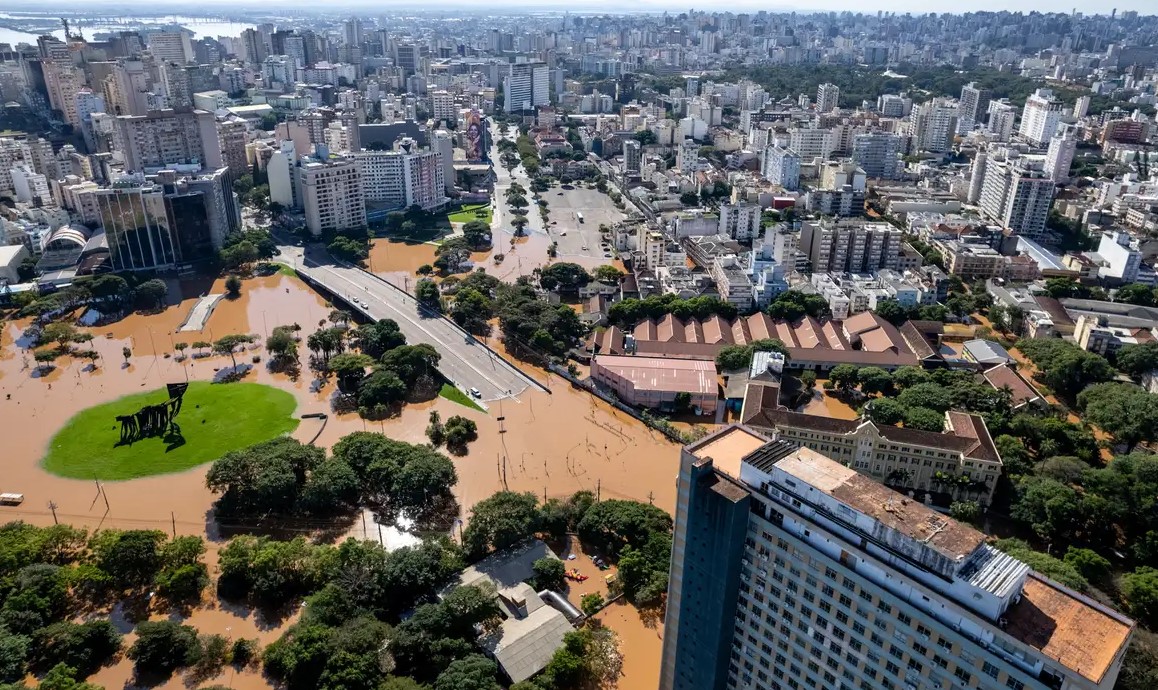

“More prevention and better preparation are needed for this intense rainfall, which will continue to increase,” researcher warns (photo: Gustavo Mansur/Palácio Piratini)
An analysis of data from weather stations shows that large contiguous areas of the region have seen more days of extremely heavy rain in the past seven decades.
An analysis of data from weather stations shows that large contiguous areas of the region have seen more days of extremely heavy rain in the past seven decades.

“More prevention and better preparation are needed for this intense rainfall, which will continue to increase,” researcher warns (photo: Gustavo Mansur/Palácio Piratini)
By Elton Alisson | Agência FAPESP – The frequency of extreme rainstorms like those seen recently in the states of Rio Grande do Sul and Santa Catarina in the South of Brazil has been increasing since 1950.
This is one of the findings of a study conducted by Brazilian researchers affiliated with the National Disaster Surveillance and Early Warning Center (CEMADEN) in collaboration with the Met Office, the United Kingdom’s national weather and climate service.
The study was supported by FAPESP under the aegis of the National Science and Technology Institute for Climate Change (INCT-MC), and is reported in an article published in the journal Earth and Space Science.
“The findings of this study point to an uptrend in the frequency and magnitude of precipitation extremes that trigger geohydrological processes such as flooding, especially in the southeast of South America, which includes the South of Brazil,” said José Marengo, a CEMADEN researcher and one of the authors of the article, during an event held on May 21 in São Paulo city by the University of São Paulo’s Institute of Advanced Studies (IEA-USP) to discuss the lessons of the extreme weather event in Rio Grande do Sul.
The article describes an analysis of data collected from more than 36,000 weather stations worldwide to assess changes in extreme temperature and rainfall events across the globe between 1950 and 2018.
The results of the analysis show that heavy rainfall events with more than 10 mm of precipitation per day were increasingly frequent in large contiguous areas of Brazil’s South region, and that rainfall rose significantly in the period (by some 2 mm per decade).
“These results corroborate the findings of previous studies that rising temperatures can increase atmospheric humidity and accelerate the hydrological cycle, leading to extremely heavy rain,” Marengo said.
“Attribution studies are needed to determine whether extreme rainfall events are due to anthropic [manmade] climate change. Some groups of researchers are conducting such studies, but we can see right away that some disasters caused by extremely heavy rain are a consequence of human activity, such as allowing houses to be built in flood-prone areas.”
Projections
In another study, published in 2021 in the journal Frontiers in Climate, the CEMADEN researchers, in collaboration with colleagues at Brazil’s National Space Research Institute (INPE), the UK’s Met Office and the University of Exeter, also in the UK, performed simulations of extreme rainfall and risks of “hydro-geo-meteorological” disasters in Brazil under scenarios assuming rises of between 1.5 °C and 4 °C in the temperature of the atmosphere.
The projections pointed to considerable changes in precipitation as a result of the different levels of warming, with heightened risks of landslides and flash floods.
The places that would be most affected by these events are in Rio Grande do Sul and Santa Catarina, according to the study. The city of Porto Alegre, capital of the former, and the Jataí Valley were the most critical in terms of flood risk.
The results were corroborated by projections for South America published in the latest reports of the Intergovernmental Panel on Climate Change (IPCC), predicting a temperature rise of between 1.5 °C and 5.5 °C in southeastern South America by the end of this century, with increased flooding and landslides as a consequence, especially in the South and Southeast of Brazil.
“More prevention and better preparation are needed for this intense rainfall, which will continue to increase. We must find ways to protect vulnerable people and the properties exposed to these risks,” Marengo said.
The article “Observed global changes in sector-relevant climate extremes indices – an extension to HadEX3” is at: agupubs.onlinelibrary.wiley.com/doi/10.1029/2023EA003279.
The article “Extreme rainfall and hydro-geo-meteorological disaster risk in 1.5, 2.0 and 4.0 °C global warming scenarios: an analysis for Brazil” is at: www.frontiersin.org/articles/10.3389/fclim.2021.610433/full.
Republish
The Agency FAPESP licenses news via Creative Commons (CC-BY-NC-ND) so that they can be republished free of charge and in a simple way by other digital or printed vehicles. Agência FAPESP must be credited as the source of the content being republished and the name of the reporter (if any) must be attributed. Using the HMTL button below allows compliance with these rules, detailed in Digital Republishing Policy FAPESP.





